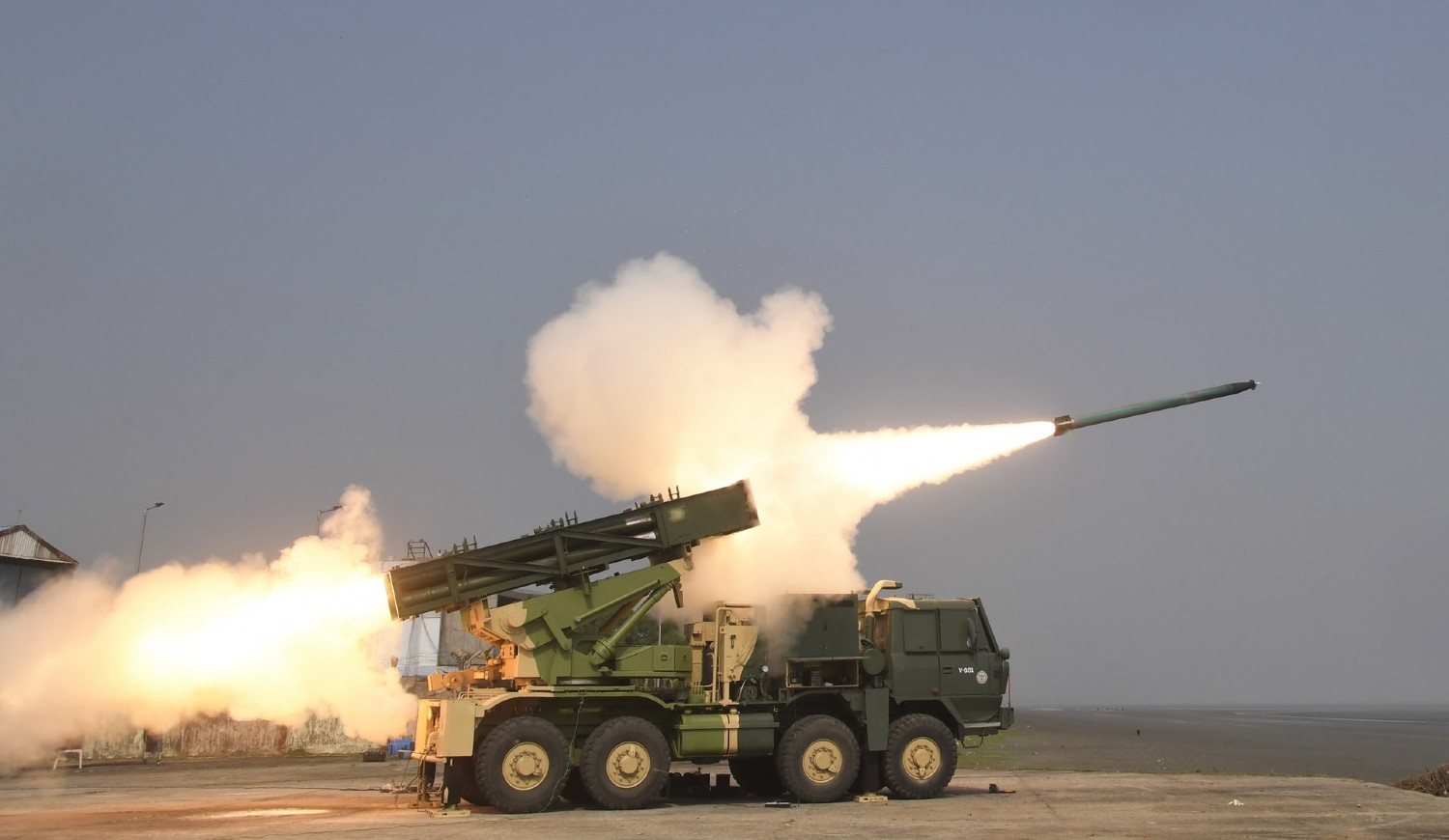India will spend nearly US$75 billion (INR 6.21 trillion) on its military, including a modernization budget of US$20 billion (INR 1.72 trillion). The modernization money will go towards purchasing fighter aircraft, warships, submarines, and mechanized fighting vehicles. In contrast, the rest of the money will go towards sustaining existing weapons and taking care of the pay and pensions of personnel.
The US$ 75 billion Indian military budget is estimated to be ten times lower than China’s unofficial spending of US$700 billion, as assessed by the American think-tank, The Heritage Foundation, in its September 2023 study. The United States spends upwards of US$800 billion on defense.
According to the Indian Ministry of Defense, the budget allocation, as presented by India’s Finance Minister Nirmala Sitharaman on February 1, would cater to “the current geopolitical scenario” and meet the “twin objectives of promoting self-reliance and (arms) exports.”
This was the final budget of Prime Minister Narendra Modi’s second tenure, and hence was also colloquially known as “interim budget” or officially as “vote on account.” The total budget for the financial year 2024-25, which would start in April, would be presented in the Monsoon Session of the Indian Parliament in July after the April-May parliamentary elections to elect a new national government for India.
The 2024-25 interim defense budget is working out to 13.04% of the total budget of the Government of India, the Ministry of Defense said in a statement. “The Ministry of Defense (MoD) continues to receive the highest allocation among the Ministries. The budgetary allocation to Defense for FY24-25 is higher by approximately (INR) one lakh crore (INR 1 trillion) or 18.35% over the allocation for FY 2022-23 and 4.72% more than the allocation of FY23-24.”
Of this, a significant share of 27.67% would go to capital expenditure for buying new weapons and military systems, 14.82% for revenue expenditure on sustenance and operational preparedness of arms and ammunition, 30.68% for pay and allowances to defense personnel, 22.72% for pensions of retired personnel, and 4.11% for civil organizations under MoD.
Upward Trend In Defense Capital Spend For Self-Reliance
The budgetary allocation of US20 billion for FY2024-25 for capital acquisitions is 20.33% higher than the actual expenditure of FY22-23 and 9.40% over the Revised Allocation for the present fiscal year 2023-24. “The allocation aligns with the Long Term Integrated Perspective Plan (LTIPP) of the three Services aimed to fill the critical capability gaps through modernization of the Armed Forces by materializing some big-ticket acquisitions in FY2024-25,” the ministry said.
The enhanced budgetary allocation will facilitate equipping the Armed Forces with state-of-the-art, niche technology lethal weapons, fighter aircraft, ships, drones, and specialist vehicles, apart from missile systems, ISR capabilities, and countermeasures for enemy capabilities. The current big-ticket purchases in the next year could include six conventional submarines with Air Independent Propulsion systems on board, 4.5 generation combat jets, Predator drone variants for the three armed forces, and warships.
Other projects could include the planned modernization of the existing Su-30 fleet, additional aircraft procurement, acquisition of advanced engines for existing MiG-29, and acquisition of transport aircraft C-295 and missile systems, which will be funded from the allocated budget.
Apart from this, to further take the ‘Make in India’ initiative, the indigenous Light Combat Aircraft Mk1 IOC/FOC configuration will be additionally funded to ensure state-of-the-art technology in domestic production. The Indian Navy projects, such as the acquisition of deck-based fighter aircraft, submarines, and next-generation survey vessels, will all materialize through this allocation.
“The sizeable allocation under capital expenditure is centered around promoting ‘Aatmanirbharta’ (self-reliance) in the defense sector. A large portion of the allocation will be utilized for procurement through domestic sources to provide domestically manufactured next-generation weapon systems to the country, which will have a multiplier effect on the Gross Domestic Product, create employment, ensure capital formation, and provide a stimulus to the domestic economy,” the ministry said.

New Measures In Defense Budget
The Economic Survey of India 2023 has projected that in the ship-building sector, the investment multiplier is around 1.82, which means that an infusion of approximately INR 1.5 lakh crore (INR 1.5 trillion) in naval ship-building projects would accrue a circulation of INR 2.73 lakh crore (INR 2.73 trillion) in the ship-building sector due to the multiplier effect.
This year, the government of India has made a conscious call to foster jointness among the services by consolidating the demand of the three armed forces into similar items of expenditure such as land, aircraft and aero-engines, and heavy and medium vehicles. This will bring flexibility in financial management by enabling the MoD to reappropriate the funds among the armed forces, considering inter-services priority. This mechanism will also expedite decision-making and ensure better utilization of the capital budget.
To enhance the sustenance funding for the operational readiness of the armed forces, the Indian government has allocated INR 920.88 billion (INR 92,088 crore) for revenue expenditure, which is 48% higher than the budgetary allocation for FY2022-23. During the mid-year review, the allocation on this head was increased by 82% over the fiscal allocation of FY 22-23, crossing the figure of INR 1 trillion for the first time.
“This aims to provide the best maintenance facilities and support system to all platforms, including aircraft and ships. It also facilitates procuring ammunition, mobility of resources, and movement of personnel, catering to the day-to-day expenditure of the armed forces in strengthening the deployment in forward areas and keeping the forces always ready to take care of any eventuality. The continued higher allocation since FY2023-24 in this (budgetary) head has resolved the troops’ grievance and improved their sustenance and operational readiness,” the ministry said.
Border Infrastructure, Coast Guard & Defense R&D
In light of the continued threat perception faced at the Sino-Indian de factor border, a jump in the Capital Budget allocation to the Border Roads Organisation continued in the next year’s budget. Since May 2020, the armed forces of the two nations have been in an eyeball-to-eyeball confrontation along the Line of Actual Control in eastern Ladakh, with the Galwan clashes being the worst ever in 40 years and the first direct clash between troopers, claiming 20 Indian military personnel’s lives and unverified claims of around 40 personnel on the Chinese side.
The allocation for FY2024-25 to boost border infrastructure such as roads, bridges, and military facilities is INR 6,500 crore (INR 65 billion), which is 30% higher than the allocation for FY2023-24 and 160% higher over the allocation of FY2021-22. “This indicates the commitment of the Indian government to improve border infrastructure.”
Besides promoting strategic infrastructural development in the border areas, the financial provision made during the budget next year will boost socio-economic development and encourage tourism. Projects such as the development of Nyoma airfield in eastern Ladakh at an altitude of 13,700 feet, permanent bridge connectivity to the southernmost Panchayat of India in Andaman and Nicobar island, 4.1 km strategically important Shinku La tunnel in Himachal Pradesh, Nechiphu tunnel in Arunachal Pradesh and many other projects will be funded out of this allocation.
The allocation to the Indian Coast Guard (ICG) for FY 2024-25 is INR 7,651.80 crore (INR 76.51 billion), which is 6.31% higher than the allocation for FY2023-24. Of this, INR 3,500 crore (INR 35 billion) is to be incurred only on capital expenditure, adding teeth to the arsenal of the ICG to address the emerging challenges posed in water and provide humanitarian assistance to other nations.
The allocation will facilitate the acquisition of fast-moving patrolling vehicles/interceptors, advanced electronic surveillance systems, and weapons.

The budgetary allocation to the Defence Research and Development Organization (DRDO) increased to INR 23,855 crore (INR 238.55 billion) in FY2024-25 from INR 23,263.89 crore (INR 232.63 billion) in FY 2023-24. A significant share of INR 13,208 crore (INR 132.08 billion) is allocated for capital expenditure.
“This will financially strengthen the DRDO in developing new technology with a particular focus on fundamental research and hand-holding the private parties through Development-cum-production partners. Allocation to the Technology Development Fund (TDF) scheme stands out as INR 60 crore (INR 60 million), which is specially designed for new start-ups, MSMEs, and academia, attracting bright young minds interested in innovation and developing niche technology in the field of defense in collaboration with the DRDO. The announcement regarding an INR one lakh crore (INR 1 trillion) corpus for Deep Tech for long-term loans to tech-savvy youth/companies and the start-ups’ tax advantage will further impetus to innovation in the defense sector.
Congratulations to Finance Minister Smt. @nsitharaman for presenting a positive and encouraging ‘Interim Budget’ which outlines the vision for a confident, strong and self-reliant #ViksitBharat. Inspired by PM Shri @narendramodi’s vision of making India a developed nation by…
— Rajnath Singh (@rajnathsingh) February 1, 2024
In a post on the social media platform ‘X,’ India’s Minister of Defense Rajnath Singh congratulated Nirmala Sitharaman for presenting a positive and encouraging ‘Interim Budget,’ which “outlines the vision for a confident, strong and self-reliant ‘Viksit Bharat’ (Developed India).” The Budget gives a glimpse of India’s rapid economic transformation, inspired by Prime Minister Narendra Modi’s vision of making India a developed nation by 2047, he said.
The defense minister added that there is a significant push for infrastructure, construction, manufacturing, housing, and technology development in this Budget. “During the COVID-19, when the world was faltering, India emerged as the beacon of hope. This Budget is perfectly aligned with PM’s ‘Panchamrit Goals,’ it also paves the way for the next five years of unprecedented growth,” he said. Rajnath Singh described the increase in capital expenditure outlay as a massive push, which will significantly boost India’s $5 trillion economy by 2027.
- NC Bipindra is a 30-year veteran in journalism specializing in strategic affairs, geopolitics, aerospace, defense, and diplomacy. He has written extensively for the Times of India, New Indian Express, Press Trust of India, and Bloomberg News. He can be reached at ncbipindra (at) gmail.com
- Follow EurAsian Times on Google News




